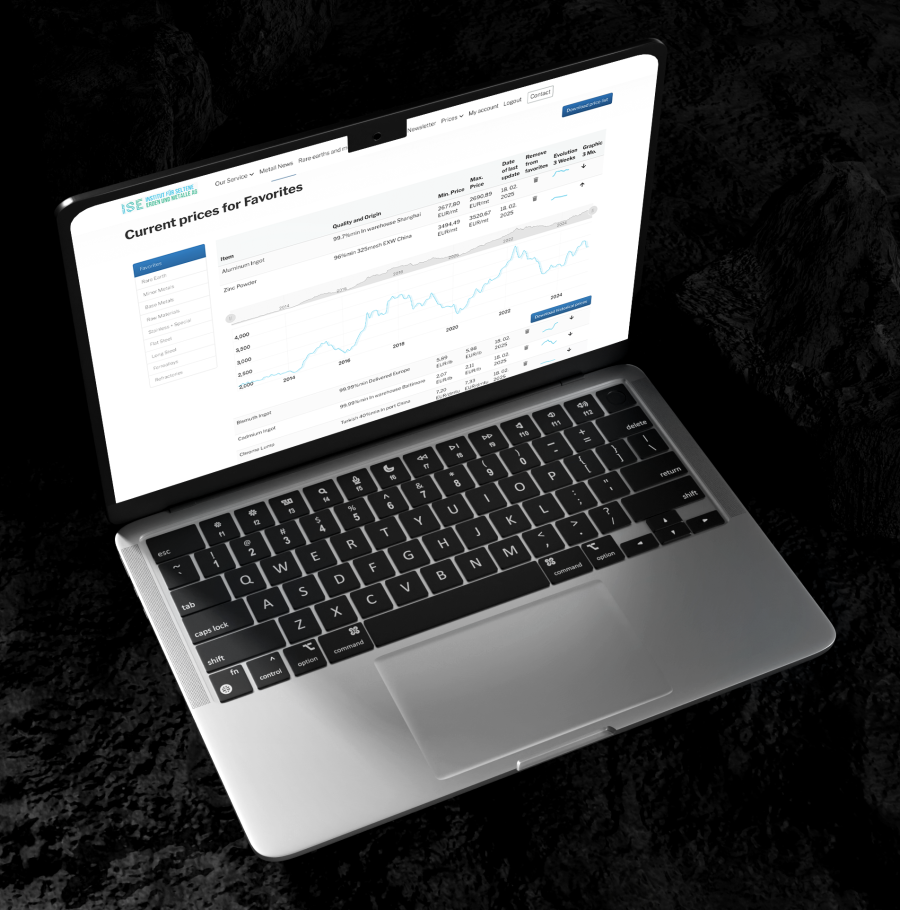ISE – Service ist unser Geschäft
ISE Way of Working
We source our metal prices from several hundred individual sources to calculate a representative average price for our customers. Our sources include major suppliers, traders, other information platforms, as well as a large number of companies ranging from mining operations to end customers. Prices for highly specific metals are determined using a simplified net present value (NPV)-based method.
Over the course of our existence, which spans more than ten years, a very extensive, organically grown network has developed. Our contacts with mine operators, traders, importers, exporters, refiners, processing industries, banks, end customers, and other price information services ensure our customers a representative average price for their goods. Even for products from very narrow markets, we have been able to establish several dozen indicators over the years.
Valuations and audits are usually confirmed as part of a due diligence process by banks, auditors, lawyers, or our clients. This is always carried out with the utmost care, speed, and confidentiality.

The Institut für Seltene Erden und Metalle AG is the partner you can rely on.

Principles and Methodology for Price Determination
In everyday language, value and price are often used as synonyms, but in economics, they differ from each other. While the price represents the exchange value measured in monetary units for a specific transaction between market participants, value refers to the aggregated price expectation of a group of market participants or a decision-making value. The price is an objectively observable figure in the market, whereas value is initially subjective and can only be derived as an objectified value through a so-called "typification."
Deviations between price and value are possible and common, as "the price of a thing does not have to correspond to its value." The element of estimation plays a significant role in this. A value is not a mathematically precise figure. Thus, different appraisers will generally arrive at different results.
IFRS 13 – Fair Value Principle
IFRS 13 defines fair value, outlines how fair value should be measured, and explains the disclosure requirements.
IFRS 13 defines fair value as the price that would be received to sell an asset or paid to transfer a liability in an orderly transaction between market participants at the measurement date. The measurement assumes that the transaction takes place in the principal market—that is, the market with the greatest volume and level of activity for the asset or liability. If no such market exists, the most advantageous market must be used. This refers to the market in which the price that would be received for the asset (or paid to transfer the liability) would be maximized (or minimized), taking into account transaction and transport costs.
Level 1
inputs are quoted prices in active markets for identical metals that are listed on the measurement date. A quoted market price in an active market provides the most reliable evidence of fair value and shall be used without adjustment in fair value measurement whenever available, with limited exceptions.
Level 2
inputs are inputs other than the quoted prices included in Level 1 that are observable for the metal, either directly or indirectly.
Level 3
inputs are unobservable inputs for the metal. An entity develops unobservable inputs using the best information available in the circumstances, which may include product-specific data. In doing so, all reasonably available information about the assumptions that market participants would use must be taken into account.
Methodological Principles
For the valuation of metals, we have adhered to generally accepted valuation principles. Since there is no universally recognized specific valuation methodology for high-purity metals according to our specifications, we apply a net present value–oriented valuation method based on researched market data.
We do not apply a cost-based method due to the lack of relevant information. This results, on the one hand, from the high degree of specification and, on the other hand, from the lack of relevant information regarding cost structures. Furthermore, as already mentioned, for fair value measurement, the market perspective takes precedence over the acquisition cost perspective.


The Valuation Procedures
Market price-oriented procedure
In the market-based valuation approach, the price observed in an active market for the asset or liability being valued is used. However, the use of common market prices requires an active market that meets the following conditions:
- The products traded on the market are homogeneous
- Willing buyers and sellers can generally be found at any time
- Prices are publicly available
Unlike financial instruments or bulk commodities, these conditions are generally not met for highly specific metals due to their uniqueness and the lack of available information.
Furthermore, the traded goods are rarely comparable, so adjustments often need to be made to account for the specific characteristics of the asset being valued (analogy method).
The net present value (NPV) approach is based on the assumption that the fair value of the asset being valued is measured by its ability to generate future cash flows.
Against this background, the planning and its underlying assumptions are an essential part of the valuation and should, as far as possible, be derived from publicly available information or at least reconciled with it. This particularly applies to the assumed useful life or service life of the asset being valued.
In the commonly used risk premium method, the risk-adjusted capitalization rate is determined by referencing a required rate of return derived from the capital market.
In our valuations, the net present value approach has been applied in a simplified form.


Cost-Based Valuation Method
The cost-based approach determines the fair value of the asset in question by calculating the necessary costs for its production, procurement, and commissioning.
Fundamentally, this method may involve either reproduction costs or replacement costs. Reproduction costs include the expenses required to create an exact duplicate of the asset being valued, whereas replacement costs cover the expenses for producing a functionally equivalent asset. Where applicable, it must be assessed to what extent deductions should be made to account for technical, physical, and/or economic obsolescence.
Cost-based methods are generally only applied when neither the market-based nor the net present value approaches can be used. In our valuations, production costs are not decisive for the fair value, as the fair value is considered a hypothetical selling price from a marketing (“exit”) perspective.

